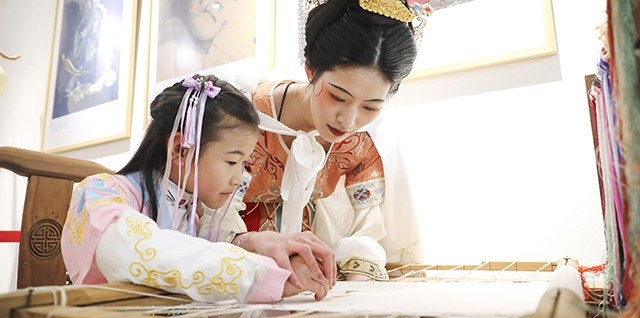Embrace culture
“漢服熱”彰顯傳統文化之精深
What do you wear when you take a trip? Most of us choose comfortable clothes like T-shirts and jeans. But Wang Tata, a post-1990s office clerk in Shanghai, is different. She prefers to wear hanfu, which literally means “Han clothing”.
去旅行你會穿什么樣的衣服?大多數人都會選擇T恤、牛仔褲一類的休閑服飾。但上海的90后白領王塔塔(音)卻有著不同的選擇。她更傾向于穿漢服。
“I’ve worn hanfu in the Tengger Desert in northwestern China, at the beach in Pingtan, Fujian province, in the Great Tang All Day Mall in Xi’an, Shaanxi province, as well as in the Forbidden City in Beijing. Wherever the scenery matches, I wear hanfu,” she told China Daily.
“我在西北的騰格爾沙漠、福建平潭的海灘、陜西西安的大唐不夜城以及北京的故宮都穿過漢服。只要與周圍的景色相襯,我就會穿漢服。”她在接受《中國日報》采訪時如此表示。
Wang is not the only one who turns to the traditional clothing. According to data from people.cn, Chinese hanfu consumers surpassed 2 million in 2018, triple the number from 2017. A recent report from Guangzhou-based consultancy iiMedia Research estimated that by the end of this year, the number of people using hanfu products in China will reach 6.89 million, with total sales expected to reach 10.16 billion yuan.
喜歡傳統服飾的并不只有王塔塔一人。人民網的數據顯示,2018年中國漢服消費者超過200萬,這一數字是2017年的3倍。廣州咨詢公司艾媒網近期的一份報告顯示,截止今年年底,中國漢服消費者規模將達到689萬人,漢服銷售額將達到101.6億元。

Why has the traditional clothing made a comeback in recent years?
為何近年來傳統服飾得以回潮呢?
For Qingzhi, a law student from Communication University of China, wearing hanfu to class every day gives her inspiration. With a history of more than 3,000 years, hanfu has had different styles in different dynasties. Qingzhi said she liked to explore various outfits within her hanfu collection. By matching the clothing with modern accessories, she can find a unique look.
對于中國傳媒大學法律系學生青梔(音)而言,每天穿著漢服去上課都會帶給她靈感。擁有3000多年歷史的漢服在不同的朝代有著不同的風格。青梔表示,她喜歡在自己的漢服衣櫥中探索各式各樣的穿搭。現代配飾與傳統漢服的搭配能讓她找到一種獨一無二的風格。
“It gives me endless inspiration every day. I can discover a new self every single day,” Qingzhi told CGTN.
“這每天都會為我帶來無盡的靈感。我每天都會發現全新的自己,”青梔在接受中國國際電視臺采訪時如此表示。
Unlike Qingzhi, Wan Yue, a mother of two, became a hanfu enthusiast for the sense of community. As someone belonging to the Han ethnic group, she said that she has always been eager to wear clothing that is representative of her community.
與青梔不同,已是兩個孩子母親的萬月(音)成為漢服愛好者是出于一種社群感。作為漢族人,她表示,自己向來熱衷于穿代表自己所屬群體的服飾。
“Seeing people around me dressing up in their traditional garments, I have also often wished to find a dress that depicts the culture of my ethnic group,” she said.
“看到周圍的人都穿著各自的傳統服飾,我也常常希望能夠找到體現自己民族文化的衣服,”她說道。
Wan not only wears hanfu in her daily life, but also learns about the culture and history behind the clothing. She told China Daily that each suit has its own cultural and historic background and learning about them gives her a better understanding of traditional culture.
萬月不光會在平日里身著漢服,還會學習漢服背后的文化及歷史。她向《中國日報》表示,每套服飾都有著各自的文化和歷史背景,學習這些知識能讓她更好地理解傳統文化。
“With the rapid development of China’s economy, people have gained more cultural self-confidence, and attention is shifting to the rejuvenation of national culture,” China Today noted. “As a symbol of Chinese aesthetics, hanfu contributes to quietly motivating a re-emerging Chinese fashion style. ”
“隨著中國經濟的快速發展,人們表現出更多的文化自信,民族文化復興受到更多關注,”《今日中國》雜志指出。“漢服作為中式美學的象征,在潛移默化中為促進國潮風復興做出了貢獻。”












